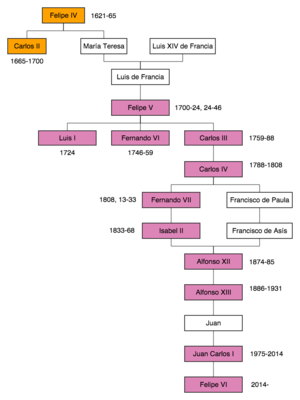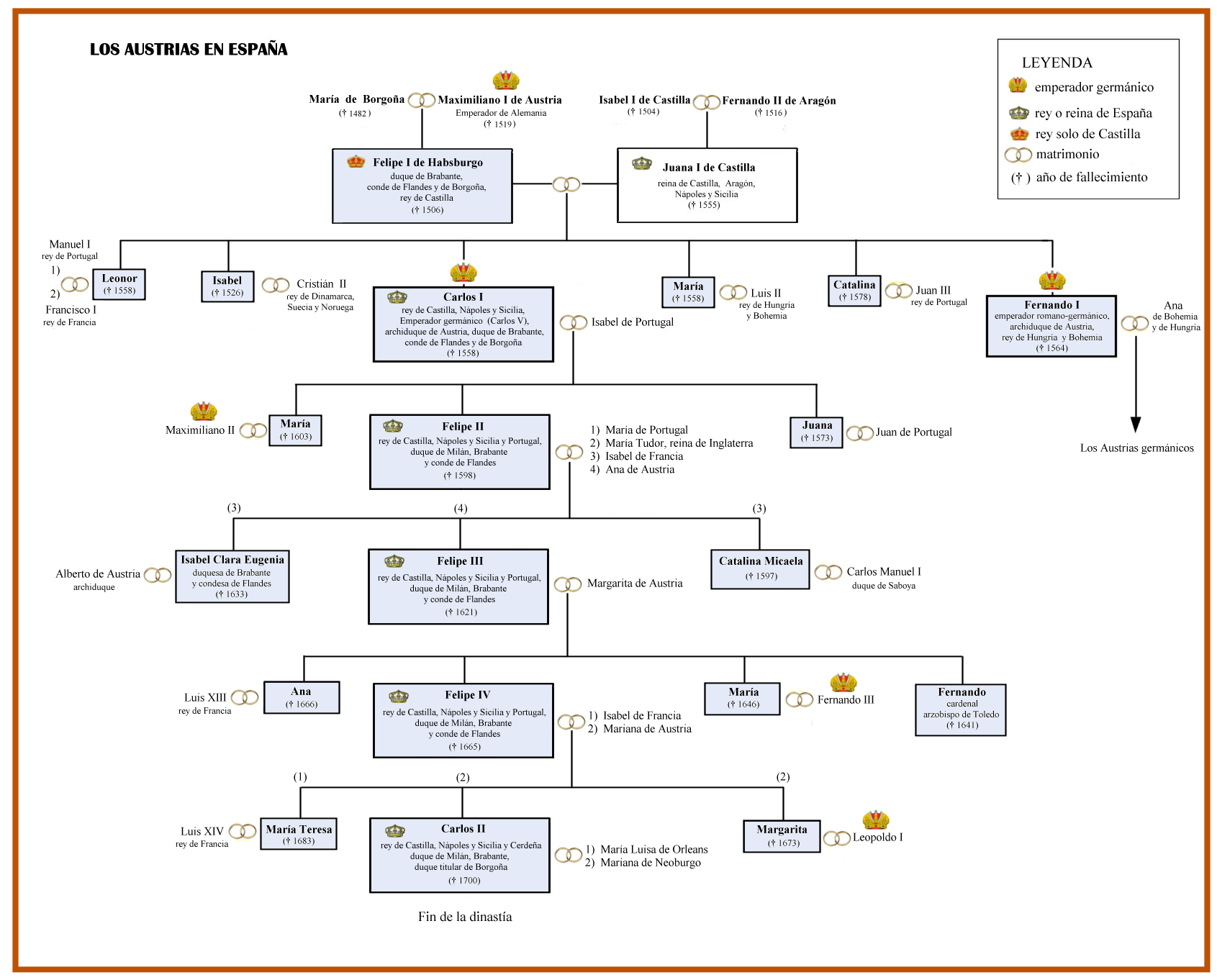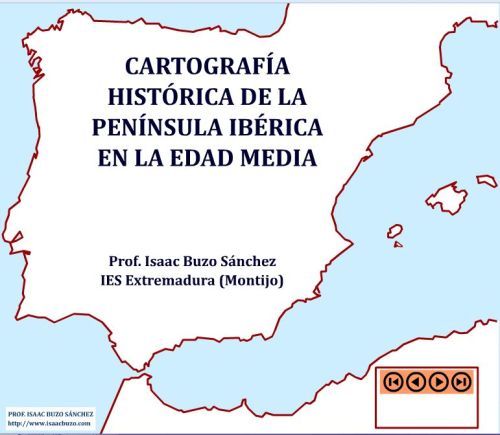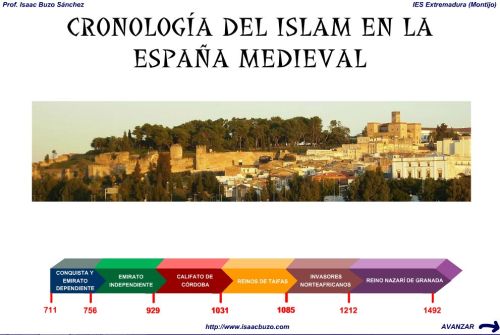SOCIAL AND NATURAL SCIENCE
Once Upon a Time... LIFE - Circulation and Respiration
Once Upon a Time... LIFE - Digestion
Questions and Answers: DIGESTION and RESPIRATION
1. What is a cell? What are the main functions it performs?
The cell is the smallest unit of life (the smallest living unit of the human body).
Like all living things, it performs the basic life processes of nutrition, interaction and reproduction.
2. What do groups of cell form? Name and explain what the functions of the different tissues are.
Groups of similar cells that work together form tissues.
Different tissues perform specific functions in the body:
- Skin tissue covers the outside of the body.
- Fat, or adipose tissue, stores fats for energy.
- Bone tissue forms bones and supports the body.
- Muscle tissue moves the different body parts.
- Nervous tissue transmits information around the body and coordinates the body’s functions.
3. What do groups of tissues form? Name five of them.
Groups of tissues that work together to perform different functions form organs. For example: the brain, the stomach, the liver, the heart and the lungs.
4. What do groups of organs form? Name a few of them.
Groups of organs that work together to perform the same function form systems that perform the basic life processes of nutrition, interaction and reproduction. For example: the digestive system, the respiratory system, the nervous system and the male and female reproductive systems.
5. What are the basic life processes different organs perform? Classify the systems each basic life process belongs to.
The basic life processes different organs perform are nutrition, interaction and reproduction.
Nutrition process: digestive system, respiratory system, circulatory system and excretory system.
Interaction process: muscular system, skeletal system, nervous system and endocrine system.
Reproduction process: female and male reproductive systems.
6. Which are the parts of the digestive system? Name them in order.
The digestive system includes the alimentary canal and various glands that produce digestive juices. The parts of the digestive system are:
- Mouth
- Pharynx
- Salivary glands
- Esophagus
- Stomach
- Liver
- Pancreas
- Gall bladder
- Small intestine
- Large intestine
- Rectum
7. Where does digestion start? Explain it.
Digestion starts in the mouth, where our teeth cut and crush the food. Then the tongue mixes the food with saliva and forms a soft ball called bolus. The bolus goes to the pharynx and down the esophagus to the stomach.
8. How many parts has the small intestine got?
The small intestine has got three parts: the duodenum, the jejunum and the ileum.
9. Which part of the body produces saliva?
The salivary glands produce the liquid called saliva.
10. Where does the body store bile?
The bile is produced in the liver and stored in the gall bladder.
11. Define: bolus, chyme and chyle.
Bolus is the soft ball produced in our mouth when the food (which is cut and crushed by our teeth) is mixed with saliva.
When the stomach mixes the bolus with gastric juices it changes into a thick paste called chyme.
In our small intestine, the chyme mixes with intestinal juice, bile and pancreatic juice, producing a thin paste called chyle.
12. What are the five most important nutrients for our body. Explain why each one is important.
The five most important nutrients for our body are:
- Carbohydrates: our body breaks down carbohydrates into sugar for energy.
- Fats, which help our body to grown and stay warm. Our body stores fats for extra energy.
- Proteins: our body uses proteins to grow and repair tissues, like muscles and skin.
- Vitamins and minerals: our body needs vitamins and minerals to work properly and stay healthy.
- And water which is essential for our body.
13. Which food contains fat? How many portions should we eat a day?
We can get fats from oil, butter and cheese. We should eat 3 portions of fats a day.
14. What do pasta and bread contain? How many portions should we eat a day?
Pasta and bread contain carbohydrates. We should eat 6 portions of carbohydrates a day.
15. Which foods have got lots of proteins in? How many portions should we eat a day?
We get proteins form meat, fish, eggs, dairy products, beans and nuts. We should eat 2 portions a day.
16. Which foods have got lots of vitamins in? How many portions should we eat a day?
Fresh fruit and vegetables have got lots of vitamins (and minerals). We should eat 5 portions a day.
17. What does a healthy diet include?
A healthy diet should include all the nutrients that our body needs. This depends on your age, your sex and how much physical activity you do.
18. Which are the parts of the respiratory system? Name them in order.
The respiratory system has got various parts:
- Nasal passages
- Pharynx
- Larynx
- Trachea
- Bronchi
- Lungs
- Bronchioles
- Alveoli
19. Which are the two actions breathing includes? Name and explain them.
Breathing includes two different actions:
- Inhalation: when you breathe in. The diaphragm moves down and the rib cage expands. This pulls air into the lungs.
- Exhalation: when you breathe out. The diaphragm moves up and the rib cage contracts. This pushes air out of the lungs.
20. Name and explain the exchange of gases that occurs when breathing.
When you breathe in, the air goes to your alveoli. The oxygen in the air goes through the walls of your alveoli and into your capillaries. Then your blood carries the oxygen to all the cells in your body.
Your blood also takes carbon dioxide away from your cells. In your lungs, this carbon dioxide goes through the walls of your capillaries and into your alveoli. Then it leaves your body when you breathe out.
DIGESTION and RESPIRATION by Luis Merino Beltrán
FOOD PYRAMID
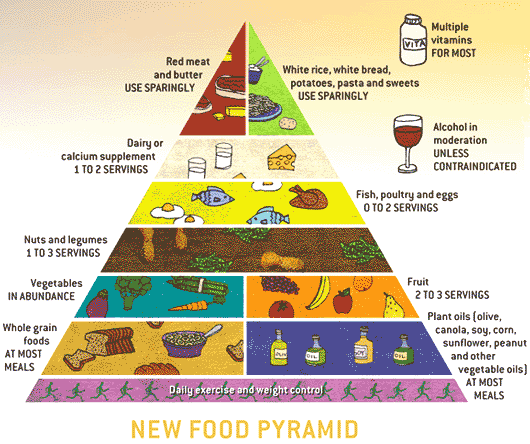
Nutrition consist of extracting nutrients and oxygen distributing them around the body and excreting the residues.
The different nutrients contained in food are:
- PROTEINS produce our body tissues and are essential for the functioning of our cells.
- CARBOHYDRATES are the most important source of energy; they include starches, which are found in cereals and potatoes, and sugars which are abundant in fruit.
- FATS give us energy. There are both animal and vegetable fats.
- MINERALS control growth and are important for the functioning of the nervous system, the contraction of muscles and the coagulation of blood.
- VITAMINS control the functioning of many of the organs in our body and help us to stay healthy.
We must follow a healthy and balanced diet!!!!
How the Human Body Works: CIRCULATION AND DIGESTION
HOW THE BODY WORKS
Click on the image to visit the KidsHealth website, with plenty of information, activities, quizzes, movies and lots of interesting facts about the human body.
Example of PET for Schools SPEAKING TEST
Proyecto: LA UNIÓN EUROPEA
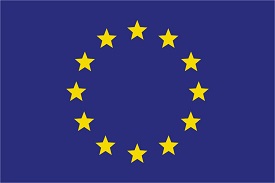
Prepara una presentación en el formato que tú quieras (sé creativo; utiliza tu imaginación), sobre el país de la Unión Europea que te haya correspondido e incluye los siguientes puntos:
- Nombre del país y su capital.
- Año de anexión a la Unión Europea.
- Bandera.
- Ciudades importantes.
- Población y superficie.
- Países fronterizos.
- Lengua/s oficial/es.
- Moneda.
- Religión.
- Sistema político. Líder político/monarca.
- Ríos y montañas importantes.
- Gastronomía, monumentos, personajes famosos, éxitos deportivos, arte, música,…
- Un poco de historia.
Visita las siguientes páginas web para obtener más información:
THE COLOURS OF OUR FLAG
In the times of King Carlos III, the Spanish flag was white, with a Picture of the royal coat of arms in the centre. White was the colour of the Bourbon royal dynasty. In other countries where the Bourbons ruled, such as France and Italy, the national flags were also white.
In those times, warships and trading ships used flags to show their nationality, but many countries had flags with the same colours. It was difficult to see the differences at a distance or when it wasn’t windy. When people saw a strange ship, they didn’t know its nationality until the ship was very close, and that could be dangerous during a war!
King Carlos III decided to change his country’s flag. He organised a competition and people created 12 different designs. The king finally chose a red and yellow design because it was easy to see on ships from a distance. That is why red and yellow are the colours of Spain’s flag today.
Questions: CONTEMPORARY SPAIN
- Who was the king of Spain on 2nd May 1808?
- Where was the Constitution of 1812 signed?
- Who became king after the War of Independence?
- Who was the first constitutional monarch? When did she rule? Which political group wanted her to have more power?
- When did the First Republic start? When did it finished?
- Who became king after the First Republic?
- When did Primo de Rivera establish a dictatorship?
- When did Alfonso XIII leave Spain?
- When did the Second Republic start? When did it finished?
- What happened in Spain during the Second Republic?
- When did the Spanish Civil War start? When did it end? Who won the war? What happened as a result?
- Who did the nationalists support during the Civil War?
- Who was General Franco? What form of government did he establish in Spain?
- When did Franco die?
- Who was Spain’s first president after Franco died?
- How do we call the years after Franco dictatorship and before the democratic elections?
- What happened on 23rd February 1981?
- Which political party won the elections in 1982?
- Which political party was in power in 1998?
- What style of buildings did the architect Antonio Gaudí design?
- What type of artist were Chillida and Gargallo?
- What style of painting was Salvador Dalí famous for using?
- Look for the definitions of the following concepts in a dictionary: military coup, republic, monarchy, dictatorship, democracy and strike.
THE FRENCH REVOLUTION
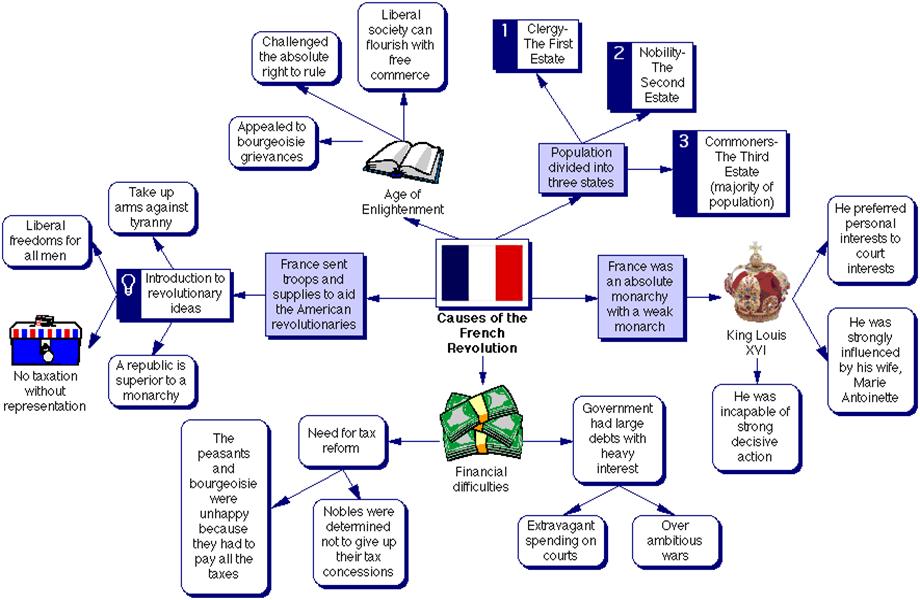
14 de noviembre: DÍA MUNDIAL DE LA DIABETES
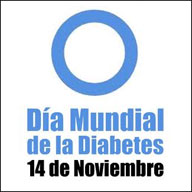
El Día Mundial de la Diabetes (DMD) es la campaña de concienciación sobre la diabetes más importante del mundo. Fue instaurado por la Federación Internacional de Diabetes (FID) y la Organización Mundial de la Salud (OMS) en 1991, como respuesta al alarmante aumento de los casos de diabetes en el mundo. En 2007, Naciones Unidas celebró por primera vez este día tras la aprobación de la Resolución en diciembre de 2006 del Día Mundial de la Diabetes, lo que convirtió al ya existente Día Mundial de la Diabetes en un día oficial de la salud de la ONU.
Pincha aquí si quieres seguir leyendo...
Questions: THE MODERN AGE
- Which event marked the start of Modern Age? When did it happen?
- Which event marked the end of Modern Age? When did it happen?
- Which were the three groups in which society was divided during Modern Age?
- Which were the privileged social groups? And the ones who had to paid taxes?
- What was the name of the social and economic group that became a powerful group? Who was in this group?
- Which were the groups that had their own courts of law?
- Who were the ones who worked on the land?
- What are the important changes that occurred during the Modern Age?
- What did European monarchs do at the beginning of the 16th century?
- Write down the six things the Catholic Kings did during their reign?
- Who was the first King of the Habsburg dynasty in Spain? How was he called?
- Write down the name of the Habsburg kings in order.
- When did Felipe II rule Spain?
- What was the dynasty that replaced the Habsburgs? Who were the kings of this dynasty during the 18th century?
- Who was the King of Spain when the Royal Academies were created?
- Write three more things that Carlos III did to modernize Spain in the 18th century.
- Which are the main artistic styles of the Modern Age?
- Which artistic style uses lots of dramatic effects?
- In what artistic style did El Greco paint?
- When was the Golden Age in Spain? Write down the name of two writers and two painters of that period.

